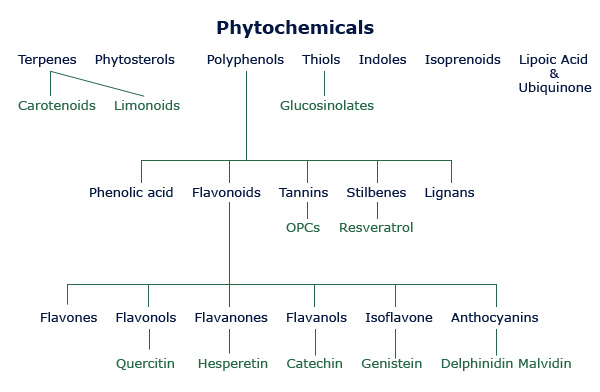Phytochemicals Prevent Chronic Illness
|
Dear Friends,
My goal in this Forward Thinking Newsletter is to help you get a hold of, or get your mind around, a class of nutrients called the phytochemicals. I know, I know, sounds boring, we’ve been there and have done that. But read on. Over the past several decades these molecules have immerged as a major focus for medical researchers and are now seen as key players in the restoration of human health around the world. Phytochemicals are now viewed as foundational deterrents against the plagues of cancer, CVD, diabetes, obesity and chronic degerative disease patterns worldwide. Historically, when we taught good nutrition in our schools, the focus was on proteins, fats, carbohydrates, fibers, vitamins and minerals. We used to call flavonoids vitamin P; cabbage factors (glucosinolates and indoles) were called vitamin U; and ubiquinone was vitamin Q. However, the vitamin designation for P, U, and Q was dropped because specific deficiency symptoms could not be established. The three vitamins were then all lumped into one huge category that we call phytonutrients or phytochemicals. Today, phytochemicals like vitamins Q, P, and U are in, and it is critically important that we understand them.
And there are so many of them! It can be quite daunting and confusing, I readily admit, to grasp and remember how and why they all fit together to make a sound nutritional picture. For example, can you arrange the following important phytochemicals into some relevant diagram: lignans, anthocyanins, carotenoids, terpenes, delphinidin, quercitin, catechins, malvidin, isoflavones, glucosinolates, flavonoids, lipoic acid, polyphenols, limonoids, thiols, phytosterols,indoles, proanthocyanidin, resveratrol, hesperetin? To help with our future discussions on phytochemicals I’ve create the following flow diagram, and in next week’s newsletter I will continue in this prediscussion foundation building by showing you molecular models for several key categories of phytochemicals.
Sincerely yours, Seann Bardell Clinical Note: Our new Energy Sustain Complex can provide a great base for a wonderful morning meal. In case you haven’t tried Energy Sustain, it contains organic amaranth, chia, quinoa, buckwheat and millet. The first four are true seeds with the millet being a true grain. They are all especially milled (like our Beta Glucan), through a patented heating process, where they are cooked enough to crach the crack the endosperm of each, liberating their soluble fibers, yet not destroying the vitamin content. The powder has a wonderful mouth feel to it like our Beta Glucan Synbiotic Formula. There is no gluten in the Energy Sustain. Take one scoop of the Energy Sustain and add a scoop of rice protein (or other pure protein sources), fresh or frozen berries, a little pomegranate juice (or other juices) and water. You can also add the Orginal Synbiotic, Triple Berry Probiotic, or No. 7 Systemic Booster for added nutrients, good bacteria, and fiber. It tastes great and really sustains our energy levels well until the afternoon! Where do you think this beautiful creature comes from? Africa? Excellent, good answer. Is it an Impala or Wildebeast? Sable? Kudu, Oryx, Waterbuck, Eland, Springbok, Duiker?—there are many kinds of antelopes in Africa. What is your guess? This magnificent creature comes in two sizes, large and a little less large. This may be a large one. An adult male’s horn can be 6 feet long with 2 1/2 twists. This one appears to have one twist, so it may be a young male. Males max out at around 600 pounds. Ok, the answer: this is most likely a Greater Kudu (as apposed to the Lesser Kudu).
|





